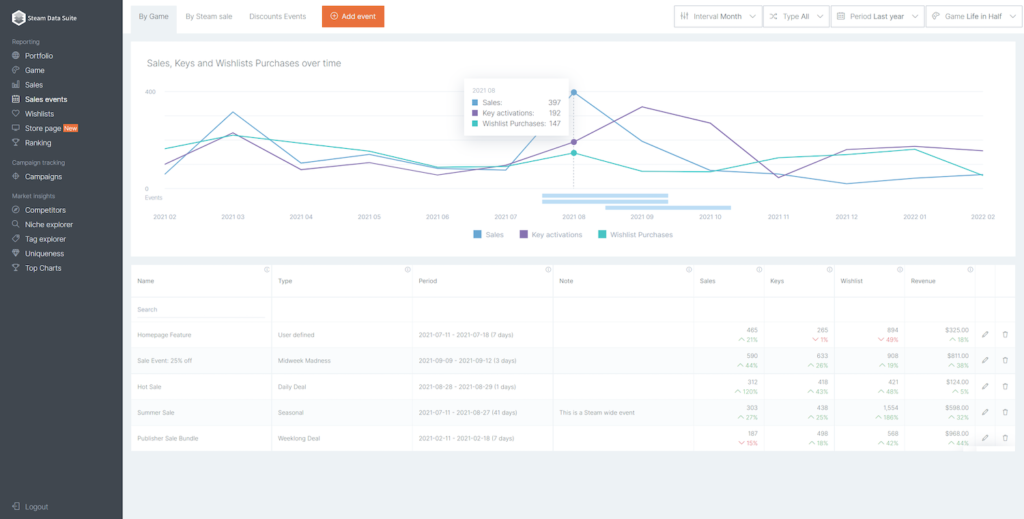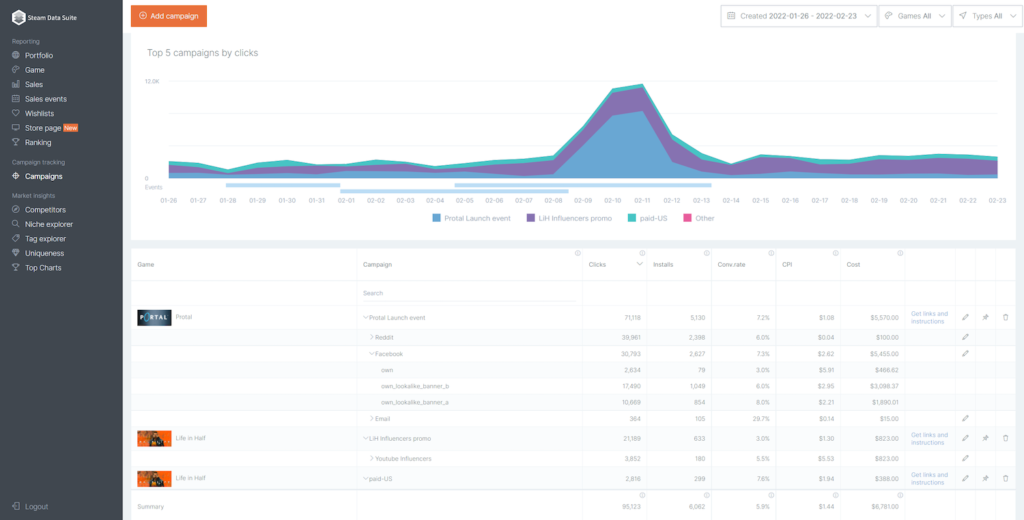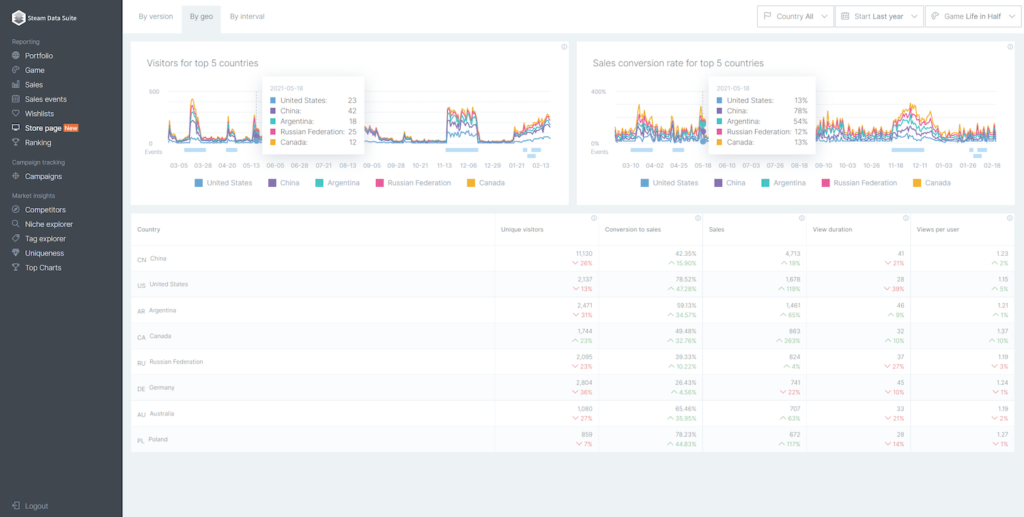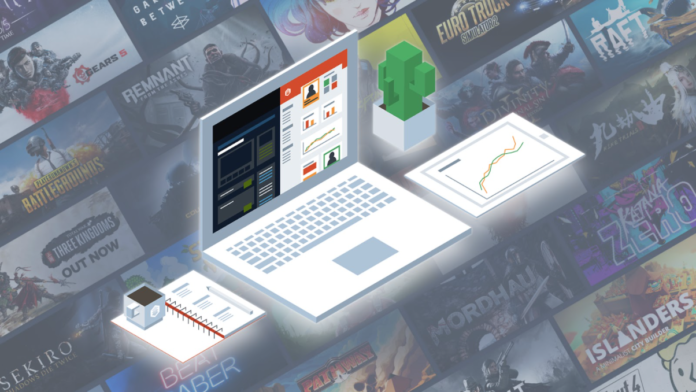Disclosure: This article has been written as a part of a paid cooperation with Steam Data Suite
Selling your game on Steam has become ever more challenging. There’s so much stuff to keep track of: Checking your game’s performance while keeping a close eye on your competitors. Finding out the best price point for each sale and promotion. Driving wishlists, tracking campaigns, watching refunds! It’s easy to get overwhelmed by all the little moving parts that make up this elusive thing: a successful game on Steam.
So how do you sell a game on Steam successfully? The first hurdle you would have to take is knowing how your game is currently doing in terms of sales performance. Unfortunately, that’s easier said than done, unless you use external tools like Steam Data Suite. Steamworks, the platform designed to serve that purpose, is commonly referred to as “black box” within the industry. While the data is technically accessible, someone looking for specific insights, e.g. the refund rate of your game in a certain country, will have to click themselves through more or less 20 pages to arrive at the table that contains the data. Fun!
Discounts drive sales
Jokes aside, let’s say you have an abundance of time to go through all the Steamworks pages to stay on top of your games’ sales performance, there is a high chance that results are not what you hoped for. Depending on your budget, there are several initiatives you can take, such as setting discounts, running marketing campaigns, or improving their store pages. Let’s start with the first one.
As demonstrated by the ever-increasing number of seasonal promotional events that Steam itself rolls out every year, discounts are an incredibly strong and popular mechanism to drive more sales for and optimally, more revenue from your games. To illustrate, games set on discount during Steam’s 2021 Winter Sale were, on average, able to lift sales by 1664% and revenue earned by 1698% compared to the two weeks prior to the sale, with an average discount percentage of 54%. Ideally, you should test out several different discounts for your games before arriving at the one that drives both, more sales and more revenue. We realize that concept might evoke flashbacks in some of you of messy Excel files containing an abundance of calculations. The things we do for money, right? Without spoiling anything, we do have a workaround in store, but more about that later.

Marketing Campaigns
What if you have already exhausted the potential of discounts, or determined that it’s not the right initiative to improve the sales numbers of your games at this point? Ask 9 out of 10 marketing specialists and the answer will be the same: Run marketing campaigns! And we couldn’t agree more. Running campaigns, especially social media campaigns involving influencer marketing have been proven to be capable of generating a significant amount of new players, and hence revenue. For example, the revival of Facepunch studio’s hit Rust is almost exclusively thanks to xQcoW, who picked the game back up in November 2021, resulting in the quadrupling of its monthly live viewership hours.
While it can almost be guaranteed that the promotion by top-tier gaming influencers will result in the desired clicks and installs for a game, they are far from inexpensive and are likely to exceed a medium-sized publisher’s marketing budget. To run profitable influencer marketing campaigns, it makes more sense to work together with multiple smaller and medium-sized influencers who are affordable but at the same time have an appropriate viewership to promote your games.
successful games on Steam frequently change their store page elements to drive more sales.
The key lies in identifying those that generate the most impressions and ideally sales for your game. The only way to do that properly is with a campaign attribution tool. We realize that the tools available to track marketing campaigns, especially for PC and more specifically for the Steam platform are scarce. However luckily, there now are solutions designed specifically to measure the performance of your marketing campaigns aimed at driving sales on Steam. If you stick around just a little longer, we will tell you what they are.

Store Page Optimization
You have identified the best discount and you are running (and tracking) successful marketing campaigns. At this point, you’re probably wondering if there is anything else you can do to improve your games’ Steam store performance. Naturally, there is, and it’s called store page optimization. Games selling successfully on Steam frequently change their store page elements to drive more sales. According to Steam Data Suite, games with a popularity rating of above or equal to 95% (according to the platform’s evaluation) change store page background images and thumbnails twice as often than less popular games, and replace videos even three times as often in order to drive discoverability and conversion.
Store page optimization should be a never-ending process if you want to consistently maximize your games’ sales performance. Adjusting the screenshots, updating the descriptions as well as exchanging tags, there are many variables that can make or break a Steam sale, and continuously revising and monitoring the effect of changes will help you optimize for conversion in the long run.

Steam Data Suite
As extensively demonstrated, selling games on Steam successfully is tough work. Not only do you have to consistently keep track of KPIs in an unnecessarily complex environment, but also perform an incredible amount of manual analysis to make sure you’re getting the most out of the initiatives you are rolling out to improve performance. We went out for you to look for solutions to help you with all that, and we think we found them in a pretty neat platform called Steam Data Suite.
Basically, it’s a set of tools that allows you to effectively analyze all the relevant data that the Steam platform is offering and more importantly isn’t offering. That way, it helps you make informed decisions when positioning your games on the Steam store. Including several sales reporting tools (Yes, no more getting lost in Steamworks) as well as proper marketing attribution for Steam and a market insight feature that helps you to stay well informed of the market including competitors, Steam Data Suite is capable of solving every pain point we described in this article.
Innovative tools
Steam Data Suite’s customers are as diverse as the games they put out. For small developers and self-publishers who lack the capacity to hire a financial analyst, the tool opens up new possibilities. The same goes for mid sized and large publishers who are looking for a viable campaign attribution solution or save considerable resources when performing competitor analyses.
Steam Data Suite is striving to give everyone a fighting chance on Steam
“We make innovative tools for a wide audience”, explains CEO Oscar Hogervorst. “We’re relying on clients to give us feedback on what to develop next. We try to work on stuff we know we think can generate more return on investment for our clients.” By making the advanced type of insights available to everyone, Steam Data Suite is striving to level the playing field and give everyone a fighting chance in the overcrowded fighting pit that is Steam.
Getting a trial account for Steam Data Suite is free.

